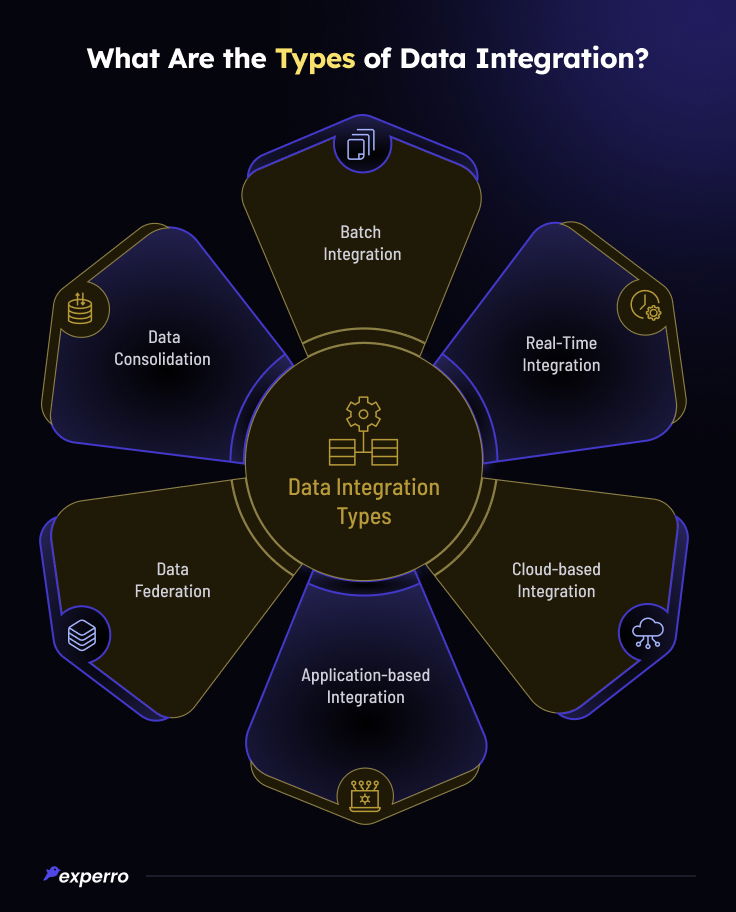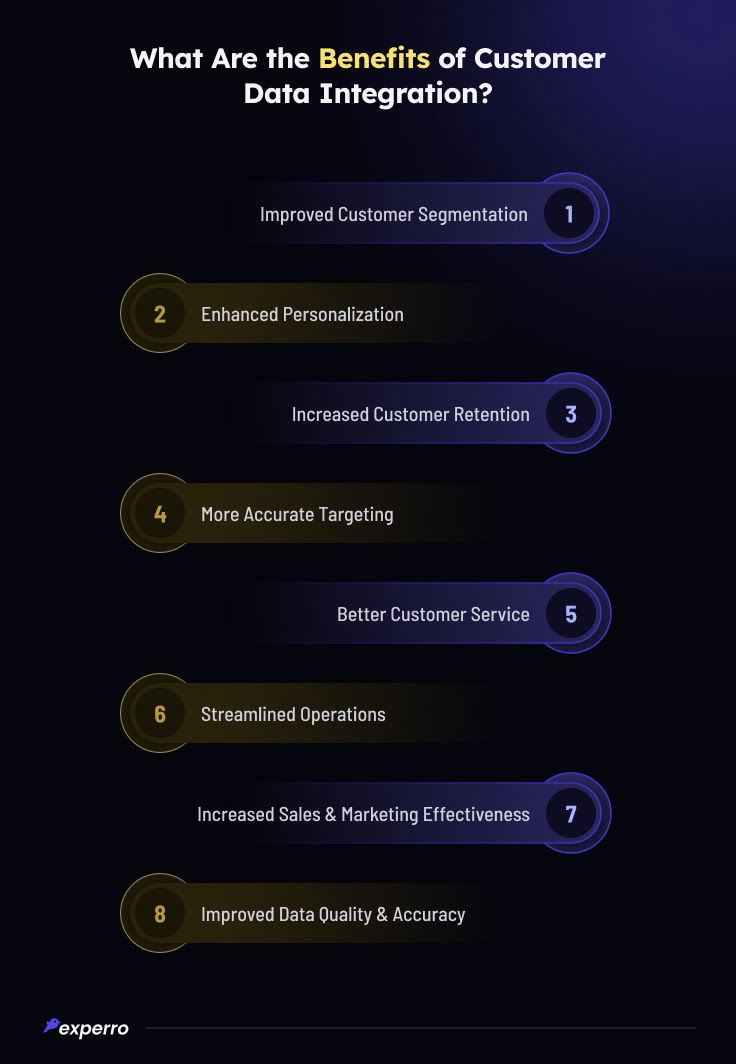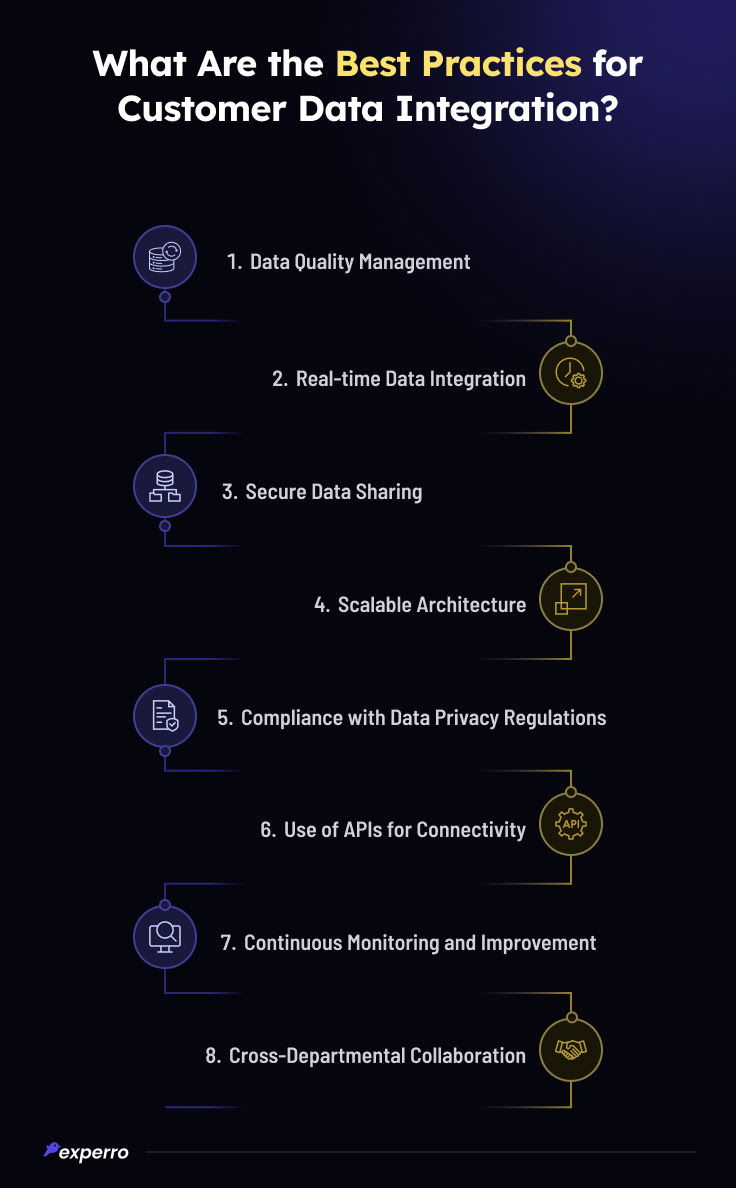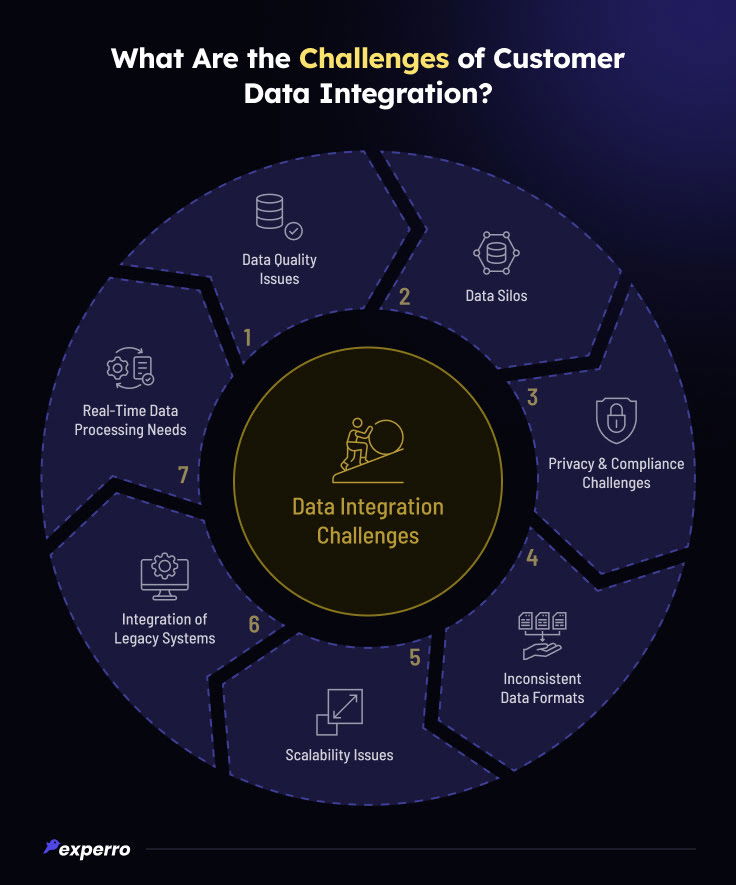What is Customer Data Integration? Why is it Essential?

What’s Inside
- What Is (CDI) Customer Data Integration?
- Why Is Customer Data Integration Important?
- What Are the Types of Data Integration?
- What Are the Benefits of Customer Data Integration?
- What Are the Best Practices for Customer Data Integration?
- What Are the Challenges of Customer Data Integration?
- Why Is Experro the Best Platform for Customer Data Integration?
- Conclusion
Key Takeaways
- Customer data integration enhances operational efficiency and customer satisfaction by centralizing multiple data sources into a unified view.
- Effective data integration requires adherence to best practices, including data quality management and secure, scalable architecture.
- Implementing robust integration tools and strategies improves customer relationship management and strategic decision-making.
- Experro excels in CDI by offering adaptable and scalable solutions, ensuring companies stay competitive and data-driven.
What is the CDI?
Customer Data Integration is the full form of CDI. It supports the integration of customer information from different sources into one complete view.
Companies can keep their data safe and accessible using customer data integration tools and software.
Successful Customer Data Platform (CDP) integration depends on following best practices and meeting specific requirements.
Companies that use CDI solutions experience major benefits, such as more accurate data and better customer experiences.
Additionally, a strong customer data integration architecture makes these processes smoother and increases the overall effectiveness of using data, boosting the strategic benefits of CDI.
What Is (CDI) Customer Data Integration?
CDI Definition: Customer Data Integration is the process of integrating and managing customer information from multiple sources into a single, comprehensive database.
CDI is crucial for businesses that aim to understand and engage their customers more effectively.
This integration process involves using customer data integration tools and software to ensure that all customer information is consistent and accessible across different systems.
A successful CDP integration streamlines data management and enhances customer experiences.
Adhering to customer data integration best practices and understanding the specific requirements are essential for implementing effective customer data integration solutions.
Why Is Customer Data Integration Important?
Customer Data Integration is essential as it helps businesses better understand their customers and improve their operations.
This makes the data more accurate and up to date, that is crucial for providing personalized customer service and making smart business decisions.
Additionally, CDI ensures that all parts of a business are streamlined because everyone has access to the same customer information.
This can lead to better customer experiences and more effective marketing strategies.
Effective CDP integration helps businesses be more competitive by improving how they manage and use their customer data.
What Are the Types of Data Integration?

Data integration is crucial for organizations to achieve a comprehensive view of their data, and there are several types that cater to different needs:
1. Batch Integration
Batch integration is a traditional data integration method in which data is collected at scheduled intervals rather than in real-time.
Such approach is effective for processing huge amounts of data, often during off-peak hours. This makes it a good fit for scenarios where immediate data updates are not critical.
It is commonly used in customer data integrations to manage daily updates as per operational requirements.
2. Real-Time Integration
As the demand for immediate data has grown, real-time integration has become essential.
This type integrates data as it becomes available, ensuring that the information in the systems is updated instantly.
This is especially crucial when integrating with a customer data platform, where timely data can significantly improve customer interactions and decision-making processes.
3. Cloud-based Integration
This type of integration involves combining data from various cloud sources with on-premises sources.
Cloud-based integration offers flexibility and scalability, reducing the infrastructure costs associated with traditional integration methods.
Many customer data integration tools are now cloud-compatible and offer robust solutions that can handle diverse data sets seamlessly.
4. Application-based Integration
This integration focuses on ensuring that applications operating within an enterprise can communicate and share data effectively.
Customer data integration software supports application-based integration.
This function synchronizes data across various systems, such as customer relationship management (CRM) or conversational commerce and enterprise resource planning (ERP) tools.
These capabilities ensure that data is consistent and up-to-date across different operational platforms.
5. Data Federation
Data federation combines data from multiple sources into a single, virtual view without merging and storing the data.
This technique is particularly valuable for CDI (customer data integration), allowing for real-time or near-real-time access to unified data, which is essential for effective analytics and reporting.
6. Data Consolidation
This process involves merging data from various sources into a cohesive set. Data consolidation is fundamental in creating a single source that businesses rely on for accurate insights.
This is particularly aligned with CDP integrations, which consolidate customer data from multiple touchpoints and are essential to understanding the customer journey.
Each integration type plays a vital role in the overarching customer data integration process and helps fulfill specific customer data integration requirements.
What Are the Benefits of Customer Data Integration?
Customer data integration (CDI) is an essential process where information from various sources is combined to create a complete, accurate profile of each customer.

Here's a detailed look at the main customer data integration benefits:
1. Improved Customer Segmentation
Utilizing customer data integration tools helps businesses divide their customers into specific segments.
This segmentation provides details like purchase history, browsing behavior, and demographics.
By understanding these segments better, companies can create targeted marketing strategies. This leads to more effective marketing campaigns that are tailored to the specific needs and preferences of each customer group.
2. Enhanced Personalization
Effective customer data platform integrations allow for a personalized approach that boosts customer engagement and significantly enhances overall satisfaction.
When customers receive messages and promotions that align with their specific preferences and needs, they feel recognized and valued by the brand.
This deepens their loyalty and increases the likelihood that they will return for future purchases. Furthermore, personalization at scale helps to reduce irrelevant messaging, which can often retain customers.
3. Increased Customer Retention
Customer data integration is key to keeping customers by helping businesses proactively meet their needs and address issues before they become major problems.
By examining the integrated data, companies can spot signs of dissatisfaction and act fast to fix them.
This method not only keeps customers but also builds trust and strengthens their loyalty towards the brand.
4. More Accurate Targeting
CDP integration helps businesses target their marketing efforts more precisely. Insights from a comprehensive view of customer data lead to more accurately targeted campaigns.
These campaigns align better with the targeted audience, improving the return on marketing investments.
This approach helps ensure marketing efforts are more effective and cost-efficient. Businesses can significantly increase their marketing success by reaching the right audience with the right messages.
5. Better Customer Service
Customer data integration software gives customer service teams a complete view of each customer. This includes their past interactions, preferences, and feedback.
With this information, service representatives can offer personalized service quickly and effectively. This improves the customer experience and increases the chances of receiving positive reviews.
It also helps in resolving issues more efficiently, further enhancing customer satisfaction. Additionally, this understanding allows teams to anticipate needs and offer solutions before customers even have to ask.
84% of companies that focus on enhancing their customer experience report a revenue increase.
6. Streamlined Operations
Customer data integration architecture creates a single source for all customer information. This allows different departments, from sales to support, to work together effectively.
It reduces internal conflicts and duplicated efforts, simplifying business operations overall.
With clearer communication and improved collaboration, teams can respond faster to customer needs. This efficiency not only boosts productivity but also enhances overall business agility.
7. Increased Sales and Marketing Effectiveness
Customer data integration solutions provide strategic insights that help businesses refine their sales and marketing strategies.
Understanding customer behaviors and trends leads to better offers that resonate with the target audience. This enhances sales and boosts customer engagement.
Furthermore, these targeted strategies often result in more efficient use of marketing resources, increasing return on investment. This tailored approach fosters a deeper customer connection, encouraging loyalty and repeat business.
8. Improved Data Quality and Accuracy
Following customer data integration best practices ensures that data across systems is consistent, current, and error-free.
High-quality data is essential for decision-making at all levels. It also enhances the reliability of business analytics and reporting.
This leads to better insights and more effective strategies. Accurate data also reduces the risk of costly mistakes and supports smoother operations, making it easier for businesses to achieve their objectives efficiently.
What Are the Best Practices for Customer Data Integration?
Customer data integration involves merging customer information from diverse sources into a unified, actionable view.
Here are essential best practices for customer data integration:

1. Data Quality Management
According to a survey by Harvard Business Review, 84% of executives have reported experiencing negative consequences due to data silos.
High-quality data is key in customer data integration. Implementing data cleansing, deduplication, and validation protocols ensures high-quality data entry into your system.
Regularly review and refine these processes. This reduces errors and improves the reliability of data analysis.
2. Real-Time Data Integration
Real-time data integration gives you instant access to updated information. It allows businesses to quickly respond to customer needs and market changes.
For this, you need strong customer data integration tools that can manage ongoing data flow effectively.
3. Secure Data Sharing
Securing the safety of data during integration is essential. It is advisable to implement robust encryption and maintain stringent access controls to safeguard the data.
Ensure these measures comply with privacy laws like GDPR and CCPA, helping maintain customer trust and avoid legal issues.
4. Scalable Architecture
A scalable customer data integration architecture is essential as your business grows.
Consider designing your systems with flexibility, so they can easily expand.
This ensures websites can handle more data as your needs increase.
5. Compliance with Data Privacy Regulations
Your customer data integration practices should protect personal information to avoid fines. Regularly update your systems to stay compliant with the latest laws.
This builds customers' trust and maintains your reputation.
6. Use of APIs for Connectivity
APIs improve how systems connect and share data in customer data integration solutions. They make data exchanges smoother and more secure.
APIs also allow for more tailored data handling, adapting to different needs and workflows.
7. Continuous Monitoring and Improvement
Keep a constant watch on your customer data integration process. Make sure everything is working smoothly.
Adjust and update systems regularly to meet new needs and fix problems. This ongoing effort helps keep your data integration effective.
8. Cross-Departmental Collaboration
Effective customer data integration needs teamwork across different departments. Combine insights from various teams to streamline the customer data.
This approach leads to better decisions and more effective strategies.
What Are the Challenges of Customer Data Integration?
CDI (Customer Data Integration) aims to merge customer information from various sources. Despite its benefits, CDI faces challenges like data consistency, system integration complexities, and privacy concerns.
Here are some major challenges of CDI:

1. Data Quality Issues
Poor data quality is one of the major hurdles for a customer data management system. Common issues include incorrect data entries, duplicates, and outdated information.
These mistakes can lead to wrong conclusions and business decisions. Regular data cleaning and validation are crucial to maintain data accuracy and usefulness.
2. Data Silos
Often, different departments store their data separately, leading to data isolation. This separation can prevent a unified view of customer information.
Integrating this isolated data into a single system is essential for effective communication and data use across the company.
3. Privacy and Compliance Challenges
Complying with data protection regulations is increasingly crucial. Companies must ensure that their data practices comply with laws like GDPR and CCPA, which protect customer privacy.
This involves secure data handling, clear consent management, and reliable data security measures.
4. Inconsistent Data Formats
Data comes in various formats, depending on the source. Aligning these formats can be challenging but is necessary for effective integration.
This may involve converting data into a common format or using software that can handle multiple formats seamlessly.
5. Scalability Issues
As a business grows, so does its data. The customer data integration system must be able to scale up to handle larger data volumes.
Scalability ensures the business can analyze and integrate customer data efficiently as it grows.
6. Integration of Legacy Systems
Older systems in a company might not easily integrate with newer technologies. Updating or modifying these systems can be costly and time-consuming.
Yet, integration is often necessary for streamlining operations and improving data accessibility.
7. Real-Time Data Processing Needs
Businesses increasingly need real-time data to make quick decisions. This requires systems that can process and integrate data instantly.
Developing such capabilities can be complex but is essential for staying competitive in fast-moving markets.
Why Is Experro the Best Platform for Customer Data Integration?
Experro is a robust DXP that is considered the best customer data integration provider.
It easily meets critical customer data integration requirements, offering scalability and adaptability through seamless third-party integrations.
This adaptability ensures that companies remain competitive by utilizing their customer data to its fullest potential, driving innovation and improving customer satisfaction.
It ensures smooth data flow across various systems, increasing data usability. This stands out as a key player in data management.
Experro adheres to best data integration practices, leading to a structured and efficient customer data management process. This approach helps streamline operations and enhances data accuracy.
Conclusion
In conclusion, Customer Data Integration plays a pivotal role in modern business strategies. It allows companies to merge and manage diverse customer information into a unified system.
This integration facilitates enhanced customer experiences and smarter, data-driven decision-making.
By implementing customer data integration best practices and utilizing robust customer data integration tools, businesses can maintain high-quality, up-to-date customer profiles.
These profiles are accessible across various departments. This approach improves operational efficiency and boosts customer satisfaction and loyalty.
Stay tuned to learn more! Or schedule a call with our team.
FAQs


Pallavi Dadhich
12 July 2024Pallavi is an ambitious author known for her expertise in crafting compelling content across various domains. Beyond her professional pursuits, Pallavi is deeply passionate about continuous learning, often immersing herself in the latest industry trends. When not weaving words, she dedicates her time to mastering graphic design.